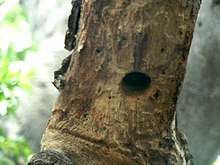Yellow-fronted tinkerbird
The yellow-fronted tinkerbird (Pogoniulus chrysoconus) is a small African barbet formerly known as yellow-fronted tinker barbet. It is sometimes considered conspecific with its southern counterpart, the red-fronted tinkerbird, Pogoniulus pusillus. Barbets are near passerine birds with bristles around the base of the bill and a world-wide tropical distribution.
| Yellow-fronted tinkerbird | |
|---|---|
%2C_crop.jpg) | |
| Scientific classification | |
| Kingdom: | Animalia |
| Phylum: | Chordata |
| Class: | Aves |
| Order: | Piciformes |
| Family: | Lybiidae |
| Genus: | Pogoniulus |
| Species: | P. chrysoconus |
| Binomial name | |
| Pogoniulus chrysoconus (Temminck, 1832) | |
Range and habitat
The yellow-fronted tinkerbird is a widespread and frequently common resident breeder in much of Africa south of the Sahara Desert. It is associated with dry open woodland and scrub.
Description
The yellow-fronted tinkerbird is approximately 11 cm (4.3 in) in length. It is plump, with a short neck, large head, and short tail. The adult has black upperparts heavily streaked with yellow and white. Its head has a strong black and white pattern, with a yellow forecrown spot. The underparts and rump are lemon yellow. Both sexes are similar in appearance, but young birds have a differentiating dark crown that lacks the distinct yellow spot.
Breeding

The species nests in tree holes and lays two or three eggs.
Vocalizations
At about 100 repetitions per minute, the yellow-fronted tinkerbird's call is a fast tink-tink-tink-tink. Many barbets perch prominently, but, unlike their larger relatives, the smaller tinkerbirds sing from cover and are more frequently heard than seen.
Diet
The yellow-fronted tinkerbird eats insects and fruit. Mistletoe fruits (Tapinanthus spp.) are swallowed whole. The sticky seeds are regurgitated and wiped off on nearby branches. Across their distribution range, yellow-fronted tinkerbirds are the most important disperser of mistletoes.[2]
References
| Wikimedia Commons has media related to Pogoniulus chrysoconus. |
- BirdLife International (2012). "Pogoniulus chrysoconus". IUCN Red List of Threatened Species. 2012. Retrieved 26 November 2013.CS1 maint: ref=harv (link)
- S.K.B. Godschalk (1985) Feeding behaviour of avian dispersers of mistletoe fruit in the Loskop Dam Nature Reserve, South Africa, South African Journal of Zoology, 20:3, 136-146, DOI: 10.1080/02541858.1985.11447926
- Birds of The Gambia by Barlow, Wacher and Disley, ISBN 1-873403-32-1
External links
- Yellow-fronted Tinkerbird - Species text in The Atlas of Southern African Birds
